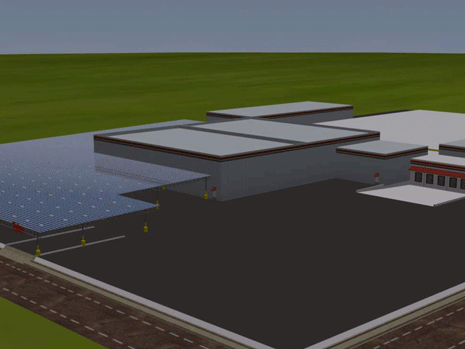
A couple of weeks back Autodesk named West Hills Construction (WHC) – a California–based contracting firm with an energy division that integrates energy management solutions into commercial, industrial and manufacturing facilities – as its Inventor of the Month. I caught up with Rusty Wood, vice president of WHC’s Energy Division, to ask him some questions about this achievement. First up, how does it feel? “It is a wonderful honour to be named Autodesk Inventor of the Month. We just saw a great tool that we could use in our industry and figured out how to make it work for us. It has paid itself back ten times over,” he says.
The types of companies that approach WHC are those that want to reduce the energy use of their facility and at the same time save money. After carrying out an Investment Grade Audit to determine what the needs of the facility are, WHC recommend a combination of different technologies including photovoltaic arrays, wind turbines and energy storage devices that interact with a facility to save the client money. “The name of the game is offsetting their energy bills over 20 year project life spans,” explains Wood.
For instance, WHC was recently contracted to design an energy management system using photovoltaic arrays for a 37-foot-tall, 86 000 square foot building that desired onsite energy generation. WHC used Autodesk software throughout the design and construction of this massive energy management system. “We use Autodesk from the very start of a job in a 2D format to get a rough idea of what we wish to design. Once we have a solid 2D design in either the standard Autodesk program (Electrical 2011, Mechanical 2011) we’ll push the 2D design over to Inventor, 3DMax or Maya to start the 3D process. Once we have completed our model in Inventor, we either take the model and push it to Showcase 3DMax, or Maya to put the finishing touches on the 3D renderings for our sales and bid presentations,” says Wood.
Although WHC have only been using Inventor for just over a year Wood reveals that they are seeing the benefits already: “We have seen a reduction in getting the job to bid and then to contracting, but the greatest efficiencies come from a higher lead to contract ratio – our bids look so amazing and professional, it seems to be a sales tool outside of it being a engineering tool!” Another benefit is that they’ve seen a reduction in material cost as they can create an exact equipment needs list for the project as they build the 3D model in Inventor. “That allows us to keep a higher net profit margin per job and reduces the need to dig into our profits or have to do a change order to the client,” he adds.
So, would he encourage other clean tech companies like themselves to invest in Autodesk’s digital prototyping tools? “Yes, we do encourage other clean tech organisations to utilise these same tools. When you can get a great company like Autodesk backing an industry it allows us to shape the programs for engineering with precision and provides specific program tools for analysing projects for our industry that we didn’t have before,” says Wood. “I’ve found other software companies just can’t offer that vertical integration of products that all communicate very well together at each stage of my projects.”
So, there you have it – a true Autodesk convert and very proud recipient of the Autodesk Inventor of the Month.







